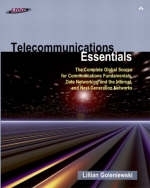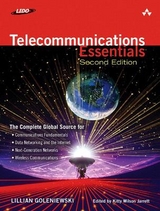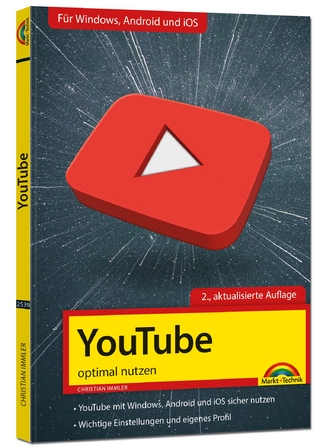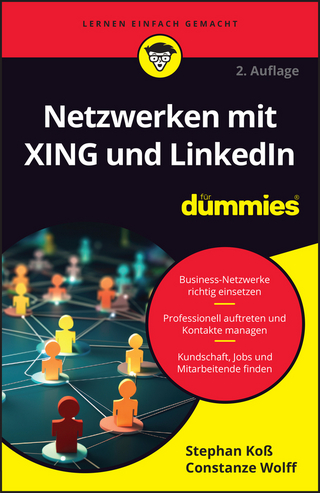
Telecommunications Essentials
Addison Wesley (Verlag)
978-0-201-76032-3 (ISBN)
- Titel erscheint in neuer Auflage
- Artikel merken
Divided into three sections, this book provides a global perspective that ensures a complete understanding of telecommunications technologies and standards worldwide. Lillian Goleniewski's clear approach to current and emerging technologies-starting with an introduction to important terms and definitions, and moving on to discussions about systems, networks, and the latest applications, products, and services-is based on the successful LIDO Telecommunications Essentials® seminar and e-Learning series. The application of this proven teaching method helps make Telecommunications Essentials a well designed tool for you as a professor.
Lillian Goleniewski is Founder and President of the LIDO Organization, Inc., an internationally acclaimed provider of education, information, and advisory services in the area of telecommunications technologies, services and networks. Ms. Goleniewski lectures extensively on telecommunications technology and management topics throughout the world. She is the author and creator of LIDO Telecommunications Essentials® (www.telecomessentials.com). Ms. Goleniewski’s seminars and eLearning series have been conducted on an international basis since 1984, and are offered throughout Asia, Australia/New Zealand, Africa, Europe, the Middle East, North America and South America. Prior to forming the LIDO Organization, Ms. Goleniewski held the position of telecommunications operations manager at the Electric Power Research Institute (EPRI), the research and development arm of the U.S. utility industry. Before joining EPRI, Ms. Goleniewski was vice-president of operations for a San Francisco-based telecommunications consulting firm. Ms. Goleniewski graduated Phi Beta Kappa and Summa Cum Laude from Wayne State University in Detroit, Michigan. She holds a B.A. in psychology and has completed numerous post-graduate studies in information technologies as well as psychology. Ms. Goleniewski was the recipient of a NSF Award to conduct research in the area of human perception and information processing.
Introduction.
About the Author.
Acknowledgments.
I. TELECOMMUNICATIONS FUNDAMENTALS.
1. Understanding the Telecommunications Revolution.
Changes in Telecommunications.
Incorporating Human Senses in Telecommunications.
The Emergence of Wearables.
Moving Toward Pervasive Computing.
Moving Toward Machine-to-Machine Communications.
Adapting to New Traffic Patterns.
Handling New Types of Applications.
Increasing Backbone Bandwidth.
Responding to Political and Regulatory Forces.
The New Public Network.
Convergence.
2. Telecommunications Technology Fundamentals.
Transmission Lines.
Circuits.
Channels.
Lines and Trunks.
Virtual Circuits.
Types of Network Connections.
The Electromagnetic Spectrum and Bandwidth.
The Electromagnetic Spectrum.
Bandwidth.
Analog and Digital Transmission.
Analog Transmission.
Digital Transmission.
Analog Versus Digital Transmission.
Conversion: Codecs and Modems.
Multiplexing.
FDM.
TDM.
STDM.
Intelligent Multiplexing.
Inverse Multiplexing.
WDM/DWDM.
Standards Organizations.
3. Transmission Media: Characteristics and Applications.
Twisted-pair.
Categories of Twisted-pair.
Applications of Twisted-pair.
Analog and Digital Twisted-pair.
Advantages and Disadvantages of Twisted-pair.
Coaxial Cable.
Characteristics of Coaxial.
Applications of Coaxial.
Advantages and Disadvantages of Coaxial.
Microwave.
Characteristics of Microwave.
Applications of Microwave.
Advantages and Disadvantages of Microwave.
Emerging Applications and Developments in Microwave.
Satellite.
Frequency Allocations of Satellite.
Satellite Network Segments.
Satellite Orbits.
Applications of Satellite.
Advantages and Disadvantages of Satellite.
Emerging Applications and Innovations in Satellite.
Fiber Optics.
Characteristics of Fiber Optics.
Components of Fiber Optics.
How Fiber-Optic Transmission Works.
Innovations in Fiber Optics: EDFAs, WDM, and DWDM.
Applications of Fiber Optics.
Advantages and Disadvantages of Fiber Optics.
Wiring for Tomorrow: Undersea Fiber Cables.
4. Establishing Communications Channels.
Establishing Connections: Switching Modes and Networking Modes.
Networking Modes.
Switching Modes.
The PSTN Versus the Internet.
PSTN Characteristics.
Internet Characteristics.
Converging Networks: The Next Generation.
5. The PSTN.
The PSTN Infrastructure.
Service Providers.
Network Access.
Access Services.
Transport Services.
PSTN Architecture.
The Transport Network Infrastructure.
The PDH Infrastructure.
The SDH/SONET Infrastructure.
Signaling Systems.
SS7 Architecture.
SS7 and the Internet.
Intelligent Networks.
AINs.
Next-Generation Networks.
II. DATA NETWORKING BASICS.
6. Data Communications Basics.
The Evolution of Data Communication.
Data Communication Architectures.
Data Communication Traffic.
Data Flow.
The DTE, the DCE, the Transmission Channel, and the Physical Interface.
Modems and Modulation.
Simplex, Half-Duplex, and Full-Duplex Data Transmission.
Coding Schemes: ASCII, EBCDIC, Unicode, and Beyond.
Transmission Modes: Asynchronous and Synchronous Transmission.
Error Control.
The OSI Reference Model and Protocols.
The OSI Reference Model.
Protocols and Protocol Stacks.
7. Wide Area Networking.
Circuit-Switched Networks.
Leased Lines.
ISDN.
Packet-Switched Networks.
X.25.
Frame Relay.
ATM.
8. Local Area Networking.
LAN Basics.
LAN Concepts and Benefits.
LAN Components.
LAN Characteristics.
LAN Transmission Media.
LAN Transport Techniques.
LAN Access Methods.
LAN Topologies.
LAN Interconnection and Internetworking.
Hubs.
LAN Switches.
VLANs.
Bridges.
Routers.
IP Switches.
Enterprise Network Trends.
9. The Internet: Infrastructure and Service Providers.
Internet Basics.
A Brief History of the Internet.
What the Internet Is and How It Works.
Internet Protocols.
Internet Addressing.
The Domain Name System.
The Organization of the Internet.
The Evolution of the POP Architecture.
Internet Challenges and Changes.
Service Providers.
Evaluating Service Providers.
The Service Provider Value Chain.
Internet Interconnection and Exchange.
NAPs.
Peering Agreements.
Private NAPs.
III. NEXT-GENERATION NETWORKS.
10. Next-Generation Networks.
The Broadband Evolution.
Communications Traffic Trends.
Communications Backbone Trends.
Communications Bandwidth Trends.
Communications Application Trends.
Multimedia Networking Requirements.
Digital Video.
Television Standards.
The Broadband Infrastructure.
Converging Public Infrastructures.
Broadband Service Requirements.
Characteristics of Next-Generation Networks.
IP and ATM.
The Broadband Architecture: Multiservice Networks.
The Three-Tiered Architecture.
The Next-Generation Switching Architecture.
QoS.
11. Next-Generation Network Services.
Traditional Internet Applications.
VPNs.
VPN Frameworks.
VPN Applications.
VPN Gateway Functions.
Benefits and Evolution of VPNs.
Security.
Firewalls.
Authentication.
Encryption.
Digital Certificates.
VoIP.
VoIP Trends and Economics.
Advantages of VoIP.
VoIP Applications.
VoIP Service Categories.
VoIP Network Elements.
Next-Generation Standards and Interoperability.
IP PBXs.
The Future of VoIP.
Multimedia on the Internet: Streaming Media.
Streaming Media Trends.
Streaming Media Applications.
Streaming Media on the Internet.
12. Optical Networking.
Optical Networking Drivers.
Components of an End-to-End Optical Network.
EDFAs.
WDM and DWDM.
Optical OADMs.
Optical Switches.
Other Optical Components.
IP over Optical Standards.
Managing Optical Networks.
13. Broadband Access Solutions.
xDSL.
HDSL.
IDSL.
SDSL.
M/SDSL.
ADSL.
RADSL.
VDSL.
HFC 401
HFC Architectures 402
Cable Modems.
Digital Cable TV Devices.
Fiber.
FTTC.
FTTH.
PONs.
Wireless Broadband Access Media.
DBS.
MMDS.
LMDS.
Free Space Optics.
Unlicensed Bands.
Emerging Media.
HomePNA.
Ethernet-in-the-Loop.
PLT.
14. Wireless Communications.
Spectrum Reuse.
Space Division.
Multiple Access Techniques.
Spread Spectrum Techniques.
Duplexing Techniques.
Compression Techniques.
Wireless WANs: Cellular Radio and PCS Networks.
Analog Cellular Networks.
Digital Cellular Networks.
Wireless Data Networks.
Cellular and PCS Standards.
3G Mobile Systems and Beyond.
Mobile Internet.
Wireless MANs.
Wireless Local Loop Applications.
Wireless Local Loop Options.
Wireless LANs.
Wireless PANs.
IrDA.
Bluetooth.
HomeRF.
15. The Broadband Home and HANs.
The Broadband Home.
The Smart House.
Intelligent Appliances.
HANs.
The HAN Market, Applications, and Elements.
Types of HANs.
HAN Gateways and Servers.
Planning for the Future.
Glossary.
Index. 0201760320T04092002
| Erscheint lt. Verlag | 8.1.2002 |
|---|---|
| Verlagsort | Boston |
| Sprache | englisch |
| Maße | 234 x 234 mm |
| Gewicht | 900 g |
| Themenwelt | Mathematik / Informatik ► Informatik ► Web / Internet |
| Technik ► Nachrichtentechnik | |
| Wirtschaft ► Betriebswirtschaft / Management ► Wirtschaftsinformatik | |
| ISBN-10 | 0-201-76032-0 / 0201760320 |
| ISBN-13 | 978-0-201-76032-3 / 9780201760323 |
| Zustand | Neuware |
| Informationen gemäß Produktsicherheitsverordnung (GPSR) | |
| Haben Sie eine Frage zum Produkt? |
aus dem Bereich



